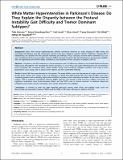| dc.contributor.author | Herman, Talia | |
| dc.contributor.author | Rosenberg-Katz, Keren | |
| dc.contributor.author | Jacob, Yael | |
| dc.contributor.author | Auriel, Eitan | |
| dc.contributor.author | Gurevich, Tanya | |
| dc.contributor.author | Giladi, Nir | |
| dc.contributor.author | Hausdorff, Jeffrey M. | |
| dc.date.accessioned | 2013-10-17T12:31:57Z | |
| dc.date.issued | 2013 | |
| dc.identifier.citation | Herman, Talia, Keren Rosenberg-Katz, Yael Jacob, Eitan Auriel, Tanya Gurevich, Nir Giladi, and Jeffrey M. Hausdorff. 2013. White matter hyperintensities in parkinson’s disease: do they explain the disparity between the postural instability gait difficulty and tremor dominant subtypes?. PLoS ONE 8(1): e55193. | en_US |
| dc.identifier.issn | 1932-6203 | en_US |
| dc.identifier.uri | http://nrs.harvard.edu/urn-3:HUL.InstRepos:11180362 | |
| dc.description.abstract | Background: Brain white matter hyperintensities (WMHs) commonly observed on brain imaging of older adults are associated with balance and gait impairment and have also been linked to cognitive deficits. Parkinson’s disease (PD) is traditionally sub-classified into the postural instability gait difficulty (PIGD) sub-type, and the tremor dominant (TD) sub-type. Considering the known association between WMHs and axial symptoms like gait disturbances and postural instability, one can hypothesize that WMHs might contribute to the disparate clinical sub-types of patients with PD. Methods: 110 patients with PD underwent a clinical evaluation and a 3T MRI exam. Based on the Unified Parkinson Disease Rating Scale, the patients were classified into motor sub-types, i.e., TD or PIGD, and scores reflecting PIGD and TD symptoms were computed. We compared white matter burden using three previously validated methods: one using a semi-quantitative visual rating scale in specific brain regions and two automated methods. Results: Overall, MRI data were obtained in 104 patients. The mean WMHs scores and the percent of subjects with lesions in specific brain regions were similar in the two subtypes, p = 0.678. The PIGD and the TD scores did not differ even when comparing patients with a relatively high burden of WMHs to patients with a relatively low burden. Across most of the brain regions, mild to moderate correlations between WMHs and age were found (r = 0.23 to 0.41; p<0.021). Conversely, no significant correlations were found between WMHs and the PIGD score or disease duration. In addition, depressive symptoms and cerebro-vascular risk factors were similar among the two subtypes. Conclusions: In contrast to what has been reported previously among older adults, the present study could not demonstrate any association between WMHs and the PIGD or TD motor sub-types in patients with PD. | en_US |
| dc.language.iso | en_US | en_US |
| dc.publisher | Public Library of Science | en_US |
| dc.relation.isversionof | doi:10.1371/journal.pone.0055193 | en_US |
| dc.relation.hasversion | http://www.ncbi.nlm.nih.gov/pmc/articles/PMC3561367/pdf/ | en_US |
| dash.license | LAA | |
| dc.subject | Medicine | en_US |
| dc.subject | Anatomy and Physiology | en_US |
| dc.subject | Physiological Processes | en_US |
| dc.subject | Aging | en_US |
| dc.subject | Clinical Research Design | en_US |
| dc.subject | Survey Research | en_US |
| dc.subject | Neurology | en_US |
| dc.subject | Movement Disorders | en_US |
| dc.subject | Neurodegenerative Diseases | en_US |
| dc.subject | Neuroimaging | en_US |
| dc.subject | Parkinson Disease | en_US |
| dc.subject | Radiology | en_US |
| dc.subject | Diagnostic Radiology | en_US |
| dc.subject | Magnetic Resonance Imaging | en_US |
| dc.title | White Matter Hyperintensities in Parkinson’s Disease: Do They Explain the Disparity between the Postural Instability Gait Difficulty and Tremor Dominant Subtypes? | en_US |
| dc.type | Journal Article | en_US |
| dc.description.version | Version of Record | en_US |
| dc.relation.journal | PLoS ONE | en_US |
| dash.depositing.author | Hausdorff, Jeffrey M. | |
| dc.date.available | 2013-10-17T12:31:57Z | |
| dc.identifier.doi | 10.1371/journal.pone.0055193 | * |
| dash.contributor.affiliated | Hausdorff, Jeffrey M | |


